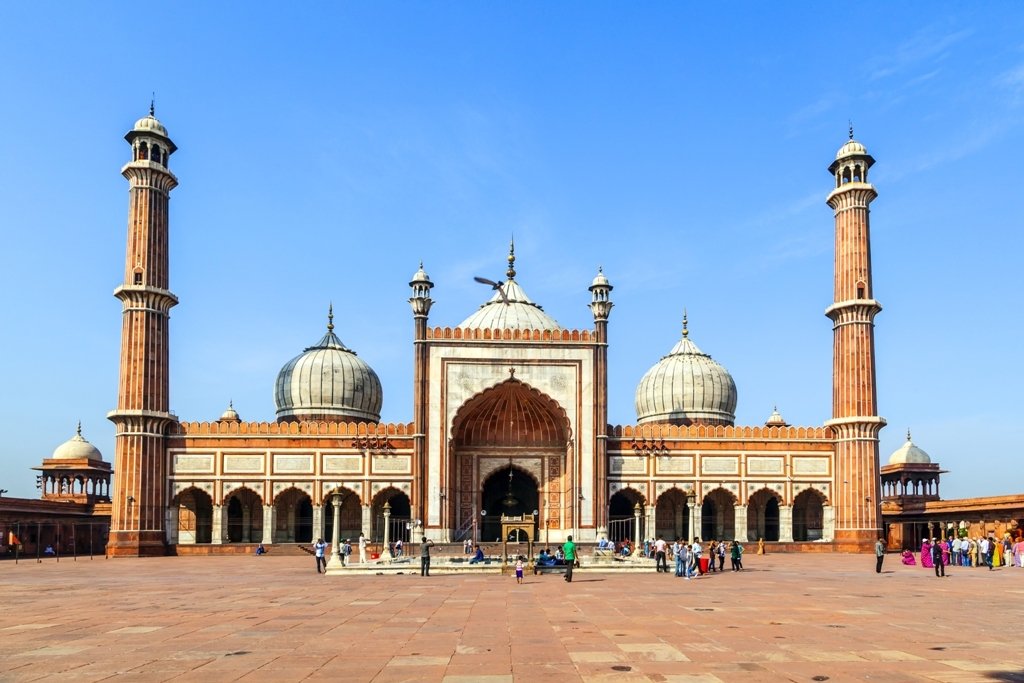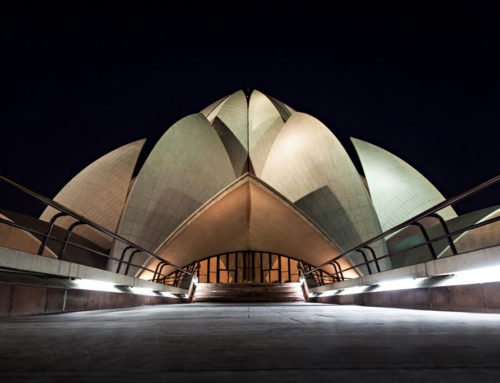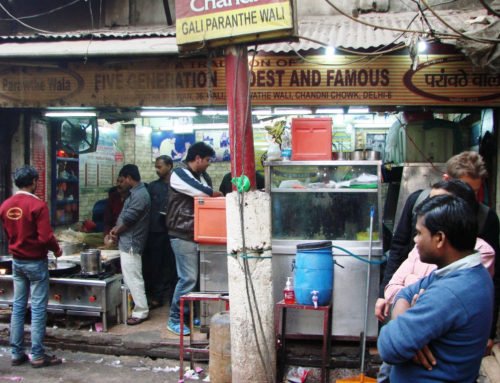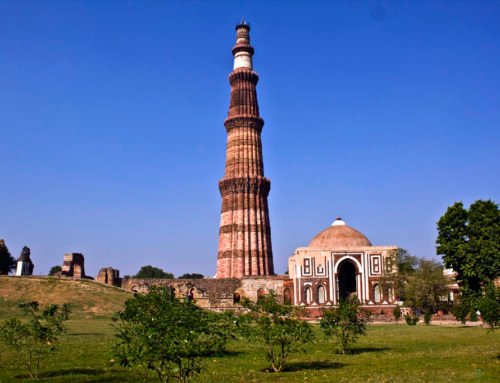Overview
- Features: Largest mosque in India with 17th-century Mughal-style architecture and soaring minarets
- Opening Times: 7am to 12pm, 1:30pm to 6:30pm, daily
- Best Time to Visit: Early morning
- Duration: 30 mins to 1 hr
- Travelled By: Metro (Chawri Bazaar)
- Cost: Camera/video Rs 200, minaret Rs 100
- Address: Chandni Chowk, New Delhi, Delhi, India
- Type: Mosque
Author Reviews[display_rating_item_results rating_form_id=”2″ rating_entry_ids=”1″ show_category_filter=”false” show_options=”true” result_type=”star_rating” preserve_max_rating=”true” show_title=”false” show_count=”false” ]
Total Rating: [display_rating_result rating_form_id=”2″ show_count=”false” show_rich_snippets=true] [accordions load=”1″] [accordion title=”User Reviews” last] [display_rating_item_results rating_form_id=”5″ show_options=”true” result_type=”star_rating” preserve_max_rating=”true” show_title=”false” show_count=”true” show_rich_snippets=true] [/accordion] [accordion title=”Add Review”][display_rating_form show_email_input=”true” show_comment_textarea=”true” show_name_input=”true” rating_form_id=”5″] [/accordion] [/accordions]
Summary
If you’re in Delhi or heading to the Indian capital, you might be interested in viewing the Jama Masjid. If you’re considering paying a visit to this magnificent attraction, continue reading for interesting facts, history, architecture, important information and FAQs about Jama Masjid Delhi.
Interesting Facts About Jama Masjid Delhi
Interesting Facts About Jama Masjid Delhi
- The Jama Masjid in Delhi is the largest mosque in India
- It is the last great architectural work of the Mughal emperor, Shah Jahan
- The mosque took twelve years and 5,000 workers to construct, at a cost of nearly a million rupees
- The mosque is capable of accommodating up to 25,000 worshippers
- The words “Jama Masjid” mean Friday Mosque
Jama Masjid History
[singlepic id=155 w=720 h=560 float=center]
The Jama Masjid was built between 1644 and 1656 by Mughal emperor Shah Jahan. It was originally called Masjid-i-Jahan-Numa, meaning ‘mosque commanding view of the world’. It was constructed by more than 5000 workers. The construction was done under the supervision of Saadullah Khan, the wazir (or prime minister) during Shah Jahan’s rule. The cost of the construction at the time was one million Rupees.
The mosque was inaugurated by a Imam Bukhari, a mullah (or Muslim priest) from Bukhara, Uzebekistan, on 23 July 1656, on the invitation from Shah Jahan.
After the British won the Revolt of 1857, they confiscated the mosque and stationed their soldiers here. They also wanted to destroy the mosque to punish the people of the city, but due to opposition they faced the Jama Masjid was not destroyed.
Jama Masjid Architecture
The Jama Masjid is much simpler in its ornamentation than Shah Jahan’s secular buildings. It has three gateways, four angle towers and two minarets standing 40m high, and is constructed of alternating vertical strips of red sandstone and white marble, which are interspersed in the domes, minarets and cusped arches.
A magnificent flight of sandstone steps leads to the great arched entrances. Symbolizing the separation of the sacred and the secular, the threshold is a place of great importance where the worshipper steps to a higher plane. There are three huge gateways, the largest being to the east. This was reserved for the royal family who gathered in a private gallery in its upper storey. Today, the faithful enter through the east gate on Fridays and for Id-ul-Fitr and Id-ul-Adha.
[singlepic id=159 w=720 h=560 float=center]
The façade of the courtyard has the main iwan (arch), five smaller arches on each side with two flanking minarets and three bulbous domes behind, all perfectly proportioned. The iwan draws the worshippers’ attention into the building. To the west (facing Mecca) is the main prayer hall with the traditional mihrab (altar) for the prayer leader.
[singlepic id=161 w=720 h=560 float=center]
The hauz, in the centre of the courtyard, is an ablution tank placed as usual between the inner and outer parts of the building for washing hands, face and feet, and to remind the worshipper that it is through the ritual of baptism that one first enters the community of believers.
[singlepic id=162 w=720 h=560 float=center]
The dikka, in front of the ablution tank, is a raised platform. Muslim communities grew so rapidly that by the eighth century it sometimes became necessary to introduce a second muballigh (prayer leader) who stood on this platform and copied the postures and chants of the imam inside to relay them to a much larger congregation. With the introduction of the loudspeaker and amplification, the dikka and the muballigh became redundant.
Important Information About Jama Masjid Delhi
In the northwest corner of the masjid there is a small shed. For a small fee, the faithful are shown a hair from the beard of the prophet, as well as his sandal and his footprint in rock.
For an extra charge you can climb the narrow southern minaret up 121 steps for incredible views over the city of Old Delhi. From the top of the minaret you can see one of the features that architect Edwin Lutyens incorporated into his design of New Delhi – the Jama Masjid, Connaught Place and Sansad Bhavan (Parliament House) are in a direct line.
Entrance is via gate 1 or 3. Visitors must remove their shoes at the top of the stairs before entering the mosque. Entry into the mosque is free; however, there is a camera charge fee to take your camera into the mosque.
Sadly, non-Muslims are not allowed in during prayers, but photographs (sold outside) of the thousands of supplicant worshipers provide some idea of the atmosphere as you wander the huge expanse within.
Getting to Jama Masjid Delhi
Jama Masjid is located in Chandni Chowk, Old Delhi. The most affordable and convenient way to get here is to take the Metro to Chandni Chowk or Chawri Bazaar stations. From there, it’s about a 1 km walk south. Alternatively, you can hop into a taxi or hire a private car for the day and be dropped right in front of the mosque.
FAQs about Jama Masjid Delhi
Below are the answers to some of the most commonly asked questions about the Jama Masjid in Delhi. If you have another question, please leave your question in the ‘Comments’ section at the end of the page.
What is Jama Masjid?
The Jama Masjid is a mosque which is a religious building and praying area for Muslims.
Who built Jama Masjid?
The Jama Masjid in Delhi was built by the Mughal emperor, Shah Jahan.
Where is Jama Masjid located?
The Jama Masjid is located in Chandni Chowk, Old Delhi, in northern India.
When was Jama Masjid built?
Construction on the Jama Masjid began in 1644. It took 12 years to build and the mosque was completed in 1656.
Why was Jama Masjid built?
The Jama Masjid is a mosque built for Muslims to say their prayers and for worship.
Tell us what you think. Are you planning to visit the Jama Masjid in Delhi? If you’ve been to this attraction before, what did you like best about the mosque?
We love to hear from you so please leave your comments below.








Jamamasjit
I have read about it
I wanna visit it for a one time
I have seen Jama Masjid Delhi many times and there are no words to praise its beauty. I will like to give some facts about this Masjid. When Shah Jahan decided to construct this Masjid he asked renowned Architects to draw design of Masjid but rejected all. He saw in dream a design, and draw Map himself. After construction he saw in dream that Prophet P.B.U.H is offering prayer. He came from Red Fort and offered Namaz several times thinking Prophet may have offered Namaz here. Water was lying on Pond where Prophet may have done Wazoo. This whole story is written in Persian on the pond meant for Wazoo and encircled with small wall of marble and can be seen. Qadam Shareef of Prophet is kept in a room and can be seen. These facts should come to the knowledge of people who visit Jama Masjid Delhi.
This was quite informative